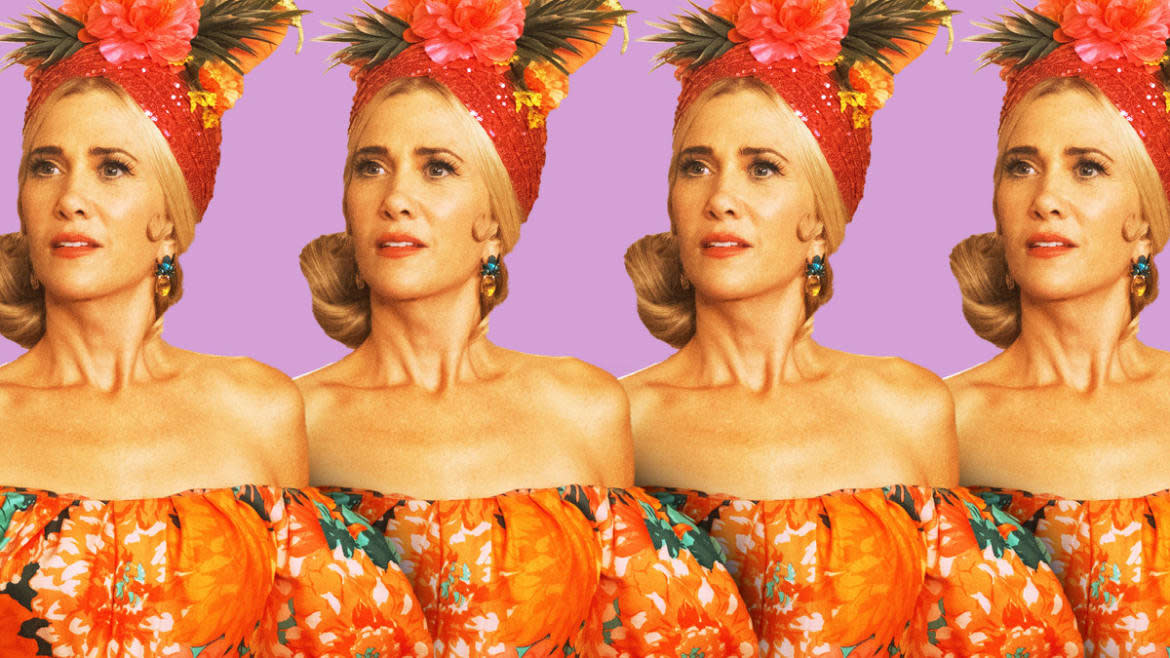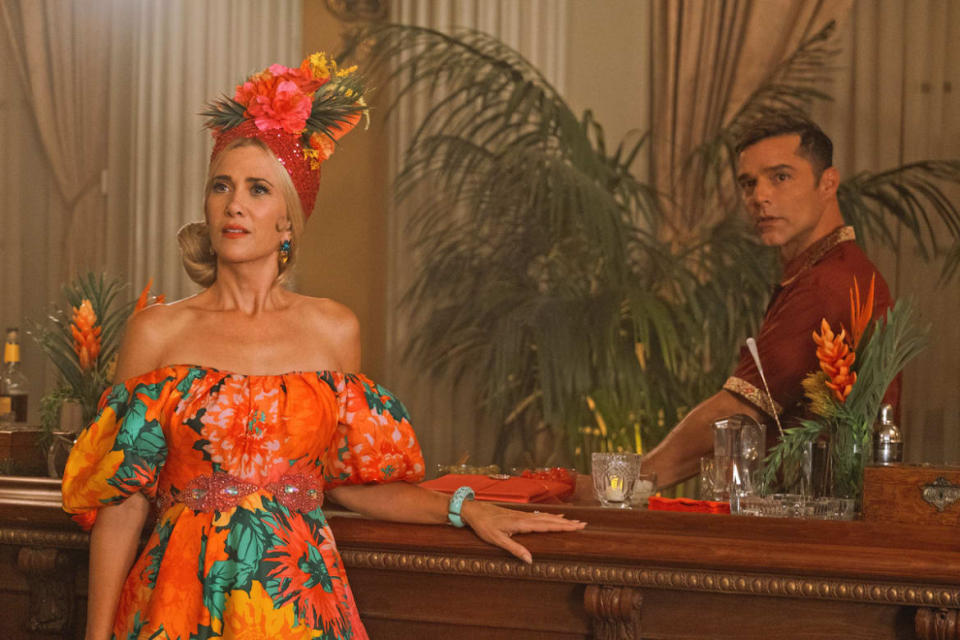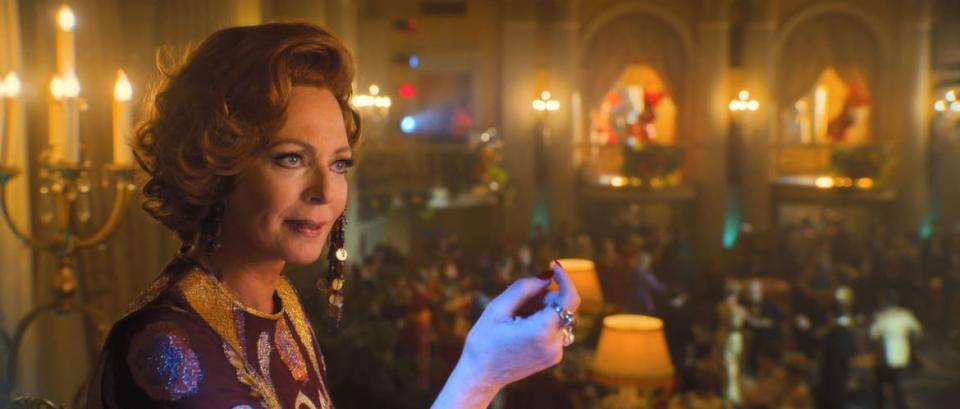How the Wild, Over-the-Top ‘Palm Royale’ Havana Party Came to Life

- Oops!Something went wrong.Please try again later.
- Oops!Something went wrong.Please try again later.
Every episode of Palm Royale (streaming weekly on Wednesdays on Apple TV+) is a visual feast, serving up technicolor cocktails, sumptuous interiors, and gowns in exuberant colors and fabrics you may not have known existed. For a series set in the tony enclave of Palm Beach in 1969, that alone could have been plenty of eye candy for viewers to enjoy. In planning the fourth episode, “Maxine Rolls The Dice”, showrunner Abe Sylvia and choreographer Brooke Lipton instead thought, “what if we did more and went bigger?” The maximalist result is a giddily over-the-top 15-minute set piece at a fundraiser gala featuring 14 showgirls, a host of background dancers, and multiple partner switches during a party-wide extended rhumba. Oh, and the scene provides plenty of forward momentum for the increasingly complicated plot machinations that main character Maxine Dellacorte (Kristen Wiig) finds herself both responding to and occasionally generating, herself.
The fourth episode is the series midpoint; Maxine’s crash course in the country club politics of Palm Beach’s seemingly ultra-wealthy doyennes is paying off in some ways and showing her just how much she doesn’t know in others. As the women jockey for status to be the queenliest of social queen bees, she has maneuvered them into supporting her application for membership at the stringently exclusive Palm Royale. Now, Maxine finds herself in yet another pickle: finally the conservator of her husband’s rich, comatose aunt Norma (Carol Burnett), but hemorrhaging the funds necessary to attend a series of mandatory, scammy fundraising galas as she prepares to host the biggest party of the year with Evelyn Rollins (Allison Janney). Zipping gamely and ineptly around the dancefloor, shifting conversational gears through multiple partner changes, whispered threats, and shared confidences is a perfect visual metaphor for Maxine’s risky juggling act.
Every moment of the Havana Nights-themed party is packed to the rafters with movement or richly textured color, and we’re usually treated to both. Maxine’s technicolor floral headdress just might topple her into the swimming pool as she half-rumbas, half-scurries across the bridge in the center of the ballroom! But wait, over a dozen sequin, satin, and feather-bedecked showgirls are bursting into the room as the band cranks up the volume and the tempo! Who can even focus on those glamorous ladies when Robert (Ricky Martin) and his effortlessly swiveling hips are seducing a fuschia-clad Raquel (Claudia Ferri) into relinquishing a ruby necklace they both know belongs to Norma! Even quieter moments, such as Evelyn serving up scathing quips worthy of Dorothy Parker as she coolly surveys the ballroom from a corner balcony, never threaten the scene’s momentum, thanks to the dozens of—actually, make that 200—background dancers shimmying and twirling for all they’re worth.
Sylvia and Lipton spoke with The Daily Beast’s Obsessed to break down how they created and shepherded this extravaganza’s many moving parts to the screen with such depth and height. Sylvia, a self-described musical theater kid who pivoted from Broadway stages to screens, knew early in the scripting process that “Maxine Rolls The Dice” would be “a wonderful moment to have one of these balls where everybody’s up and dancing anyway, to create a madcap farce around the rumba.” Incorporating multiple dance partner switches would create unexpected pairings, offering “a new and fresh way for our entangled stories to weave together.”

Kristen Wiig and Ricky Martin
Bringing a Maximalist Vision to Life
Going this hard for the sake of the plot’s forward momentum was entirely optional: Sylvia could have just as easily re-used settings like the Palm Royale’s steam room or golf course to do his storyline weaving, but as he explains, “I think the how of a story is as important on this show as the story itself. So from the costumes to the sets across the series, I’m thinking, ‘What makes this scene a Palm Royale scene? What makes it stand out? What makes it maximalist?’” Achieving this vision and raising the stakes demanded a unique space. After nixing an outdoor location in Beverly Hills as too unpredictable, the scene—complete with a custom-built swimming pool topped with a curved bridge to provide even more visual volume—was shot across four days in one of the ballrooms at the Biltmore Hotel in Los Angeles.
When Sylvia saw the alternate space, he instantly pictured “a showgirl in each balcony” and several more roaming the room, serving cocktails. Even in a ballroom whirling with color and texture, the custom-built costumes for each dancer stand out as a multi-textured riot of feathers, tassels, sequins, ruffles, and lamé, all in hot tropical shades of yellow, orange, pink, and fuschia. Choreographer Lipton’s experience creating dance numbers that look especially great on TV—honed by her years of experience on series like Glee—was essential; she knows how to fill the frame with engaging movement and flourishes that “just keep going bigger, bigger, bigger,” she says, at every turn.
Casting professional dancers for every role but the speaking parts contributed to the visual abundance of each moment of heightened reality. Sylvia credits Lipton with much of the scene’s visual coherence, adding that her “Rolodex of badass dancers, who brought so much life and integrity and chemistry and humor” to their work, provided a vital soupçon of physical grace. In fact, all of the background performers in dance scenes and tracking shots across the series are professional dancers, a choice Sylvia made “because of the way they carry themselves, and the beauty of their gestures,” which made them essential to showcasing what an “elevated, elegant world” they were creating.
Kristen Wiig’s ‘Palm Royale’ Was Designed in a Lab for You to Enjoy
Getting the Moves and the Lines Just Right
The cast of first-rate comedic actors—including Allison Janney, Leslie Bibb, and Julia Duffy—needed both rehearsal time and the flexibility to roll with on-set adjustments as needed. Throughout the shoot, Lipton balanced a host of priorities, including timing, space, budget, efficiency, and movement that matched the energy of the characters and the scene as a whole. Her iterative process involved creating and revising choreography that was fully integrated with the script to prioritize the actors’ need to make sure their lines landed, and avoid getting stuck on things like “a silly arm movement that doesn’t make sense” for their characters. It worked so well that Wiig often learned her choreography from her stand-in just before shooting each of her many moments on camera. Sylvia described witnessing this with wonder, noting that “there's a spontaneity to Kristen’s performance that's really exciting.”
A cavalcade of comedic moments throughout the set piece ratchet to ever higher heights, thanks to the outrageousness of everything that’s going on. Maxine dances with five partners in 15 minutes, none more memorable than the daffy, yet slightly terrifying Mary Davidsoul, played by Julia Duffy. Fans of classic 1980s and ’90s sitcoms will fondly recall Duffy from her roles in Newhart and Designing Women, and won’t be at all surprised to learn that she ran with the choreography Lipton and Duffy’s stand-in dancer Jessica Keller designed for her dance with Wiig. Because Duffy is so petite, her choreography initially featured lots of “tiny little mannerisms”, but in rehearsal, Lipton says, she “was so aggressive! We realized, ‘Oh, we’ve been dancing a little bit small.’” Duffy’s knack for finding unexpectedly off-kilter moments shines when she unnerves Wiig’s Maxine by gripping her unnecessarily tightly as she dances the “boy’s” part of their rhumba.

Allison Janney
The Secret Ingredient Is Sincerity
When asked about the campiness of Palm Royale, Sylvia is reflective and thoughtful, noting that the term is suffering a bit from overuse. Besides, “true camp doesn’t know it’s camp, and there’s an intentionality to what we're doing here.” He considers Palm Royale as existing in a long lineage of pastiche in queer filmmaking, “where you're borrowing from all pop culture, you throw everything into a blender, and form a new aesthetic.” Sylvia’s touch points include the Doris Day and Rock Hudson classic Pillow Talk and the films of Douglas Sirk and Todd Haynes, but he credits the award-winning queer Spanish filmmaker Pedro Almodóvar as his most significant influence.
“In the tone of his movies you swing from melodrama, to whimsy, to magical realism, back to soap opera. and thriller on top of it,” he says. “There’s something about borrowing from the past and filtering it through our own personal lens that I’ve always admired and responded to in his work.”
Like his forebears, Sylvia treats his over-the-top characters with care, always taking them seriously, “so even as we’re being witty and chewing the scenery” with such exuberant, loud visuals and escalating juicy storylines, “the emotional reality and the pathos is still there,” he says. Sylvia feels particularly fortunate in the choice of Kristen Wiig as his leading lady, whose performance he regards as “magic.” She wants so desperately to be enmeshed in a very surface-oriented world, but “even when she’s doing her big, farcical characters, the reason that people find her so funny is that she’s actually very real. On top of the fantasy and whimsy, there’s real pathos in everything that she does.”
Get the Daily Beast's biggest scoops and scandals delivered right to your inbox. Sign up now.
Stay informed and gain unlimited access to the Daily Beast's unmatched reporting. Subscribe now.

